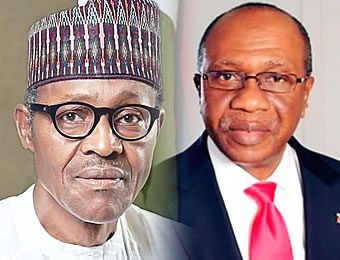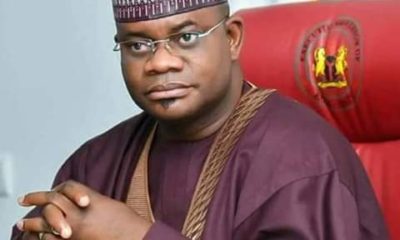Economic Issues
FG, Emefiele, And The CBN’s Recent Monetary Policy Considerations -By Temitope Laniran

In the last couple of days, I have been eagerly waiting for the March 25th and 26th Monetary Policy Committee meeting of the Central Bank of Nigeria (CBN) and its outcomes for two reasons. The first one is personal, which I choose not to disclose and the second is to obviously see what they will do with the rates, not just for the purpose of the rates’ sake, but to see the perception of the economy by the monetary authority; being the first post-election meeting and perhaps the last but one to be presided by the current governor of the Bank.
The Nigerian economy has certainly been struggling at least for

The Committee also kept the credit reserve ratio at 22.5 per cent. Evaluating the current state of the economy would be quite a daunting task, with a lot of uncertainty at the moment. The immediate post-election period has seen the Nigerian Stock Exchange loose over N200 billion in its market capitalisation by the end of the first week of March and has continued to remain bearish, a trend that may continue till perhaps end May 2019, when the swearing-in of new administrations of government would have been concluded. The re-elected federal government has also promised a shake-up in its cabinet, which in itself holds some level of uncertainty, in terms of who gets what portfolio and when, as the current regime is notoriously known for its precedence in the cabinet appointment delay. Other uncertainties include: the barrage of litigations likely to follow the ways and manners the last elections were conducted and; the institutional quality and respect for the rule of law, which is a reoccurring discussion in recent times; as well as the continued violence and conflicts across the country in the different forms and manners they come, amongst others.
Bearing all these in mind and its implication for investment, among other issues, would almost necessitate an easing, albeit cautious on the side of the monetary policy, to cushion some adverse effects for the economy. Indeed, it can be argued that maintaining an expensive naira by the MPC through till the elections, bearing in mind the usual increase in liquidity that often leads up to elections, was a quite reasonable decision, however with the current trends and turn of events in the post-election period, a reduction in rates would almost be the next best move for the Bank. While the ability of this reduction in achieving any serious impact remains to be seen, however, for what it’s worth and at least for some “feel good” effect, this remains a logical option.
It is important at this point to provide some basic knowledge on monetary policy. Weiss (1995) referred to monetary policy as measures set out to influence money growth and interest rate level in an economy. The key concerns here are the amount of money in circulation in an economy and the value of such amount. This provides a basic background environment for economic activity, as it ensures that firms and consumers can make decisions on economic activities in a stable and predictable environment, thereby encouraging economic growth and full employment. Irving Fisher, whose quantity theory of money lays a crucial foundation for monetary policy through his equation of exchange (M.V = P.Q, where M = the nominal amount of money in circulation, V = the velocity of circulation, P = price level and Q = the number of transactions) claims that economic aggregates are not affected by money, but prices. However, Keynes later proposed that other economic variables are indirectly affected by money through an influencing of the interest rate, which is a crucial determinant of investment and cash held by economic agents. He argued that unemployment is a function of inadequate aggregate demand and that an increase in money supply will increase spending, thereby generating an increase in aggregate demand which, as a result, increases employment levels and translates to economic growth.
A reduction in the monetary policy rate (MPR), hypothetically, should mean an encouragement for banks to increase liquidity and reduction in interest rate through the market mechanism, thereby stimulating loans and investment; hence an expansionary impact on the economy. However, in Nigeria, and many other sub-Saharan African countries, the transmission mechanism through which this occurs is quite weak. Ideally, it is expected that a reduction in MPR will stimulate consumer credit, increase consumption and ultimately aggregate demand, which at the moment is quite low, as noted by the CBN governor. Unfortunately, the weak transmission mechanism earlier noted already questions the ability of such reductions in MPR to achieve its set out objectives.
I ultimately doubt that it would have any significant impact on real investment. However, in terms of equity, it may give some initial inertia, but nothing substantial. Also, I doubt if borrowings for investment purpose will move up because, beyond just the MPR, other institutional, political and qualitative factors remain unfavourable. I mean, we’ve seen the outright disregard for the rule of law under the current regime, to regression in the quality of our political space and political stability in the just concluded election. I dare say that save the Lagos and Oyo State elections, where our famous “elenu jawaya” knocked himself and his party out completely, I doubt if there is any other state that there is no form of litigation or the other going on, challenging the results of the polls, including the presidential election.
Also, there has to be a significant reduction in the rates for fixed instruments to serve as a disincentive for banks to just hold money, and serve as an incentive to lend. But more importantly, with the current appetite of government for taking loans and our current structure of deficit budgeting, there is certainly going to continue to be an outright crowding out effect of the private sector, hence the little window that the reduced MPR could have had to improve investment will most likely be lost.
The CBN also noted a need for a second rebasing of the GDP. While this is a welcome idea as it will provide a better fundamental understanding of the most recent structural changes going on in the economy, however, going by most recent trends and sense of ongoings in the economy, the evidence for structural transformation being sought for may not be found.
A structural transformation can be easily referred to as the reallocation of economic activity away from the least productive sectors of the economy to the more productive ones. It is one fundamental driver of economic development. It contains two elements: the rise of new, more productive activities and the movement of resources from traditional activities to these newer ones, raising overall productivity. Structural changes in most advanced economies come as a result of the transfer of resources from the primary to secondary sector, and ultimately the tertiary sector. In this process, high productivity is achieved, as well as wealth redistribution. It, however, appears that Nigeria and indeed most other sub-Saharan African (SSA) countries bypassed the secondary sector to service sectors.
The manufacturing sector that necessitates growth in value addition and ultimately helps in job creation has not necessarily grown. What is noticeable is that a de-industrialisation trajectory is observable, coupled with an unproductive rise in consumerism. For example, the rise in the services sector’s share of the GDP, together with gradual or no increases in the shares of industrialisation and agriculture, may have significant implications for sustaining the growth.
The Nigerian economy still remains largely susceptible to fluctuations in the commodity (oil) market, despite the evidence found for structural transformation during the previous rebasing exercise. There still remains a crucial need for the implementation of the Petroleum Industry Bill (PIB), not just for the petroleum sector alone but also the value chain effect it potentially can achieve by the fiscal arm of policy. Also the need for the revision of the Multi-Year Tariff Order (MYTO) for reasons of energy issues remains important for the reduction in rates to have any substantial effect on the economy, as well as allow for an increase in inflow of foreign exchange for real and substantial direct investment purposes that can drive employment and aggregate demand as against just the very fluid portfolio investment we have been witnessing in most rest recent times.
Temitope



















